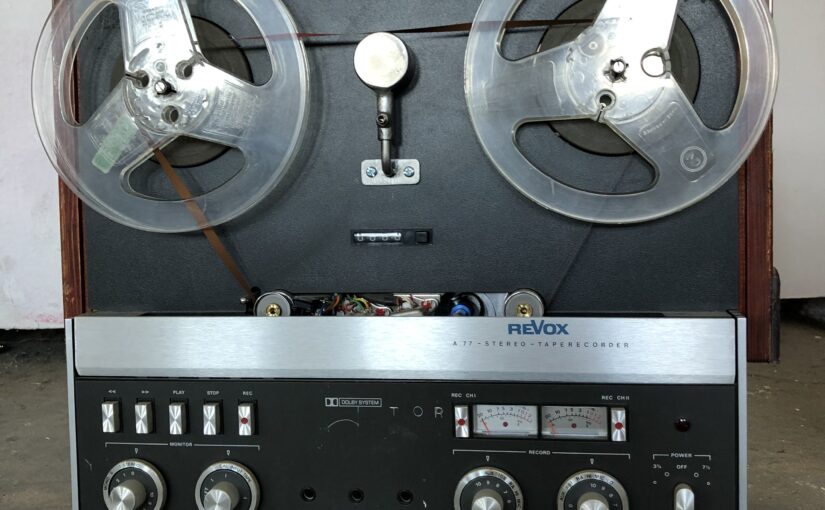1. Favourite knob/fader/switch on a piece of gear and why?
I like the MORPH on Make Noise Morphagene because magical sounds appear from playing with that knob and getting gene overlapping, random pitch shifting and stereo panning.

2. Do you have an ‘almost’ perfect bit of kit? What would you change?
At the moment I’m very pleased with Make Noise Morphagene. I like the way it expands on classic tape machine splicing techniques in a complex and real-time way. I would like to be able to replace the buffer continuously while being modulated, I love when live sampling another instrument, how the sampling shifts along with the instrument when changing it.
3. What setup do you bring on holiday/tour/commute etc.?
A nice compact set-up would be my Zoom H2N and Aquarian Audio H2a hydrophone, Razer laptop and Elektron Octatrack – Then I have the opportunity to both record some new sounds and play around with them, and the computer for Max patching.

4. What software do you wish was hardware and vice versa?
I would love to run Max/Msp patches on embedded SBC hardware for creating custom abstract musical instruments and self-running sound installations. It has been attempted with ex. Lattepanda that can run Windows, but if Max/Msp would be compatible with Linux for starters, it would be easier. Another way would be to turn to Pure Data -Max’ open source sibling, which has more options on this front.

5. Is there anything you regret selling… or regret buying?
Not really, but I do sometimes regret hacking my Revox A-77. I got it for free a long time ago, because it didn’t work. I fixed it and decided to create a new instrument from it where the motor pulling the reel is dynamically controlled by a Max/Msp sequencer so it sequences the reels playback – It turned out to be a really strange sounding, but cool instrument. Sometimes though, I do wonder why I had to use exactly that machine and not just any tapemachine.

6. What gear has inspired you to produce the most music?
My Elektron Machinedrum is one of my first machines, and I have used it for a great deal of projects. Especially using the RAM machines for live sampling, is where it really goes off-grid, using the main input level on the recorder to create gnarly feedback. And sending tracks, machines or instruments through it, to create sampled sequences that interplay with existing sounds.

7. If you had to start over, what would you get first?
Of course it would be nice to have developed skills like programming and circuits from an early age, or going into hardware synths earlier. But I don’t mind that I didn’t. My initial way of creating music was purely intuitive, not having any theory to lean on made it honest and from within, in a different way than now.
8. What’s the most annoying piece of gear you have, that you just can’t live without?
Mutable Instruments Braids – Can’t get it to sound perfect, but for some reason I won’t sell it because it has a certain “promise”.

9. Most surprising tip/trick/technique that you’ve discovered about a bit of kit?
Using re-trigger on Machinedrum with a Random LFO on re-trigger modulation and re-trigger gain to create out of sync beat repeats and melodic stuff.
And the “IDM in a box” trick, using the CTR-ALL machines to make crazy glitchy things – thanks to Rui Peixoto for the great video!
Artist or Band name?
Julie Østengaard.
Genre?
Sound Art, Electroacoustic/Acousmatic, Ambient, IDM.
Selfie?

Where are you from?
North Sealand, but I have lived in Copenhagen for about 10 years now
How did you get into music?
I started playing electric guitar with my childhood friend, which turned into acoustic guitar, writing and playing singer/songwriter type music. I soon got an electric bass, some multi effect pedal and I think a pro tools license, which thereafter slowly started the evolution into electronic music – I guess Julie with the acoustic guitar didn’t see this coming.
What still drives you to make music?
Music technology, curiousness and learning new things. The depths of music technology never cease to amaze me, every time I get to know something new, I don’t seem to feel the world of music contracts, but rather it expands and a new world appears, of possibilities and things to grasp. There are so many exciting ways to interact with music, and to express through music. Music is so closely related to both physics and math, but music is also something that you can approach very intuitively, making it possible to unite both thinking and feeling.
How do you most often start a new track?
Often I start by creating limitations, like a specific technology, method, theme, a set of rules, a specific sound or such, and then I seek to push the boundaries of those limitations, which is where I think I’m most creative and inspired. Sometimes, I am more interested in how the sounds are created than how they sound, and I’m not set out to create something that only sounds good, but the journey there must also be interesting.
How do you know when a track is finished?
I compose and record all my pieces by playing them live. I like that it keeps me very present in the music I create, and gives the music a sort of liveliness too, with the small imperfections that can’t be edited away afterwards – at some point I know, that doing another take will not contribute to the artistic nerve, but stifle it – then, the piece must be finished.
Show us your current studio

Promote your latest thing… Go ahead, throw us a link.
instagram: http://instagram.com/sisterevertone
website: https://www.julieoestengaard.com/
latest live set: https://www.julieoestengaard.com/quarantine-session
[Editor: Do you have a favorite tip, trick or way of working with any of the gear from this interview?
Then throw a comment below…]
